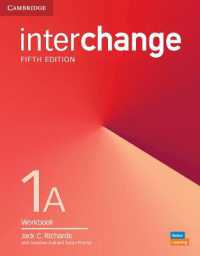Full Description
Constitutional adjudication is a subject of fascination for scholars. Judges may annul the will of a democratically elected Parliament in counter-majoritarian fashion. Although conceived as a remedy against majoritarianism, judges also decide cases by voting. Whether they do so through simple majorities or supermajorities is not trivial.
The debate around supermajorities has awakened anew amidst theories of judicial limitation and new conceptions of judicial review. This book advances our knowledge of systems employing supermajorities in constitutional adjudication by performing a comparative analysis of ten jurisdictions and twelve supermajority models. It introduces a typology of the main models of institutional design, the reasons leading policymakers to establish them, and the impact supermajorities have on courts. It explores the question of whether supermajorities grant deference and foster consensus, or if they disable constitutional courts from exercising judicial review. By analyzing the history, practice, and effects of supermajority rules in courts, this book contributes to an ongoing conversation on the democratic implications of voting protocols in constitutional courts. It will be a valuable resource for policy-makers, scholars, and researchers working in the areas of comparative constitutional law and constitutional politics.
The Open Access version of this book, available at http://www.taylorfrancis.com, has been made available under a Creative Commons Attribution (CC-BY) 4.0 license.
Contents
Acknowledgments xii
PART I
THEORY OF SUPERMAJORITIES 1
1 Introduction 3
1.1 Why Supermajorities? 3
1.2 Scope of the Book 4
1.3 Overview of the Main Arguments and Approach 6
1.4 Plan of the Book 8
2 Voting Protocols and Supermajorities: A Conceptual Introduction 10
2.1 Voting Protocols in Constitutional Adjudication 10
2.1.1 Introduction 10
2.1.2 Types of Decision-Making Thresholds 12
2.1.3 Quorums and Majorities 16
2.2 A Brief History of the Discussion on Supermajorities in Constitutional Adjudication 17
2.2.1 The Birth of a Debate 17
2.2.2 The Debate in the Scholarship 21
2.3 Looking Ahead 27
PART II
SUPERMAJORITIES IN PRACTICE 29
3 Historical Supermajorities 31
3.1 The United States Subnational Supermajorities: The Birth of Supermajorities 31
3.1.1 The First Supermajority: From Rebellion to Extinction in Ohio's Supreme Court (1912-1968) 32
3.1.1.1 Constitutional Convention Deliberations: Unraveling the Supermajority Debate 34
3.1.1.2 The Supermajority and Ohio's Supreme Court: The Sabotage Campaign 36
3.1.1.3 Practice and Demise 38
3.1.2 North Dakota: A Nonpartisan Supermajority (1919-Present) 42
3.1.2.1 The NPL and the Supermajority's Adoption 42
3.1.2.2 The Rule's Functioning 45
3.1.2.3 Assessing the Rule's Success 52
3.1.3 Nebraska (1920-Present) 54
3.1.3.1 Constitutional Convention Discussion in Nebraska 54
3.1.3.2 The Rule's Practice 57
3.1.3.3 Surviving Reform: An Assessment of the Supermajority 62
3.2 The Supermajority in the World's First Constitutional Court: Czechoslovakia (1920-1938) 64
3.2.1 Introducing a Supermajority 66
3.2.2 The Rule's Functioning 68
3.2.3 Demise and Assessment of the Rule 72
3.3 What Does History Teach Us? 74
4 Contemporary Supermajorities 75
4.1 Peru: A Jurisdiction of Many Supermajorities (1963, 1982, 1995, and 2002) 75
4.1.1 The Supermajority in the Tribunal of Constitutional Guarantees (1982-1992) 76
4.1.2 The Fujimorists' Supermajority 81
4.1.3 The Supermajority in Peru's Contemporary History 87
4.1.3.1 The Birth of a New Supermajority 87
4.1.3.2 Practice of the Contemporary Supermajority 88
4.1.3.3 Expansion of Supermajority Rules by the Constitutional Court 93
4.2 The Supermajority in the Contemporary Czech Constitutional Court (1993-Present) 96
4.2.1 Czechoslovakia's Heritage: The Resurrection of the Supermajority 98
4.2.2 The Supermajority in Practice 99
4.2.3 Assessing the "Silent" Supermajority 105
4.3. Bargain and Transition: The Mexican Supermajority (1995-Present) 108
4.3.1 From Otero to the Supermajority 108
4.3.2 The Mexican Supermajority at Work 111
4.3.3 Scholarship and Politics: The Controversies on the Supermajority Rule 116
4.4 The Dominican Republic: A Consensus Supermajority (2010-Present) 122
4.4.1 A Consensus Rule: Adoption and Objectives of the Supermajority of the Dominican Republic 123
4.4.2 The Consensus Supermajority in Practice 124
4.4.3 Scholarly and Political Debate 131
4.5 The Illiberal Supermajorities: Transitory Supermajority Rules in Poland and Georgia (2015-2016) 132
4.5.1 Poland: The Threat of Court Paralysis (2015-2016) 133
4.5.2 Georgia: A Six-Three Supermajority (2016) 136
PART III
A COMPARATIVE ANALYSIS OF SUPERMAJORITIES IN CONSTITUTIONAL COURTS 139
5 An Empirical Theory of Supermajority Rules: Exploring the Why and How of Their Institutional Design 141
5.1 The Aims of Institutional Design: Deferential and Decisional Supermajorities 141
5.1.1 Deferential Supermajorities 141
5.1.1.1 Breaking Collegial Neutrality: The Shadow Court and Decisional Power Redistribution 141
5.1.1.2 Supermajority Failure Decisions and Impasse Rules 143
5.1.2 Decisional Supermajorities 144
5.1.2.1 Lack of Deferential Nature 145
5.1.2.2 Decisional Supermajorities and Impasse Rules 146
5.1.3 Mixed Models 148
5.2 The Legal Source of Supermajority Rules 149
5.2.1 Constitutional Supermajorities 150
5.2.2 Statutory Supermajorities 152
5.2.3 Court Self-Imposed Supermajorities 154
5.2.4 Judicial Review of Supermajority Rules 157
5.2.4.1 Ohio (1930) 159
5.2.4.2 Peru (1996) 160
5.2.4.3 Poland (2016) 162
5.2.4.4 Georgia (2016) 164
5.3 Supermajorities Beyond Theory: A Peek Behind Policymakers' Reasons 165
5.3.1 Cautious Supermajorities 166
5.3.2 Deference as a Core Goal 167
5.3.3 Consensus within the Court 169
5.3.4 Supermajorities as Weapons 170
6 How Do Supermajorities Impact Constitutional Courts? Consensus Requirements and Paralysis Assessment 174
6.1 How Do We Calculate Supermajorities? Full Court and Quorum Models 174
6.1.1 The Numerical Model: Mobile Supermajority Thresholds 175
6.1.2 The Fractional Model: Playing with Decimals 178
6.1.3 Countering the Mobile Threshold Problem: Formal Rules and Informal Practices 181
6.1.3.1 Formal Rules 181
6.1.3.2 Informal Practices 183
6.2 Justifying a Supermajority Threshold: An Empirical and Theoretical Debate 184
6.2.1 Threshold Arbitrariness? Scholarly Discussion of Threshold Justification 186
6.2.2 Searching for Objective Thresholds 187
6.3 Court Paralysis in Practice: The Start of an Empiric Discussion 189
6.3.1 Threshold Impact: A First Overview 191
6.3.1.1 A Threshold Typology 191
6.3.1.2 Qualitative Overview 193
6.3.2 Nuanced Court Paralysis 195
6.3.2.1 Overview of the Impact of Supermajority Rules in Decisional and Deferential Supermajorities 197
6.3.2.2 General Implications 199
7 Conclusions 203
7.1 Main Findings 203
7.1.1 Institutional Design 203
7.1.2 Impact on Courts 204
7.2 Broader Implications 205
7.3 Future Research 206
Appendix: Data sources/Collection methods 207
Bibliography 213
Index 236






